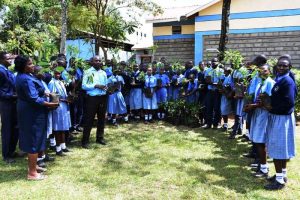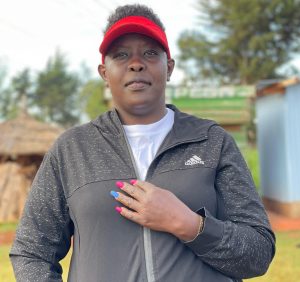Remarks by PS Mueke During the Agrihack Meeting

It is my pleasure to join you today at this event – the Kenya Agrihack; the first of its kind where minds meet to develop innovative, climate-smart, and gender-responsive solutions for reducing post-harvest losses in grain, dairy, and horticulture.
Post-harvest losses occur in the space between harvest and consumption and can be caused by various factors such as pests, diseases, improper handling, and lack of appropriate storage and transportation facilities.
These losses do have significant economic and food security implications, reducing the availability of food for consumption and leading to financial losses for farmers and other stakeholders in the food supply chain.
According to studies, Kenyan farmers are losing between 20% and 40% of their hard-earned produce due to post-harvest losses representing financial losses of up to USD 500 million. If this were any other business; such losses would be catastrophic, potentially leading to bankruptcy. This is not just a mere percentage; it is the difference between prosperity and poverty for our dedicated farmers. Of greater concern, these losses are passed down the value chain, ultimately affecting consumers, who are burdened with higher prices.
Ladies and Gentlemen,
The issue of post-harvest losses troubles our agricultural sector and demands our immediate attention and innovative solutions now. I have been told that this meeting specifically, will focus on dairy, cereals and horticulture. These value chains are integral to Kenya’s economy and well-being. They contribute to food security, employment, income generation, foreign exchange earnings, and economic growth, while also playing a role in diversifying diets and improving nutrition. Their development and sustainability are central to Kenya’s agricultural and economic future.
Post Harvest Losses in Kenya
Whether in dairy, cereals or horticulture, the first significant factor contributing to post-harvest losses in the Kenyan agricultural sector is poor post-harvest handling practices at the farm level. Many farmers are not aware of best practices for reducing post-harvest losses. They often lack the knowledge and resources to maintain proper hygiene, maintenance of a cold storage, inadequate sanitation and refrigeration facilities at the farm level resulting in the rapid multiplication of bacteria and spoilage of most agricultural commodities thus reducing their quality and shelf life. For example, inadequate drying, threshing, and winnowing techniques can lead to increased moisture content, making grains susceptible to fungal growth and mycotoxin contamination which then become unfit for human and livestock consumption. Unhygienic handling of milk will easily make it contaminated.
Second, in many rural areas of Kenya, there is lack of good transportation infrastructure which makes it challenging to collect and transport milk, cereals and horticultural produce from smallholder farmers to processing centers. This results in spoilage and deterioration in quality of these perishable commodities during transit, leading to significant losses.
Third, poor processing and preservation techniques lead to post-harvest losses as most small-scale processors often lack access to modern equipment and technology, which results in spoilage and waste. Traditional preservation methods may not be effective in extending the shelf life of dairy products, cereals or horticultural products leading to economic losses for both farmers and processors. Most packaging materials designed to extend shelf life are often beyond the reach of small-scale farmers in Kenya, leading to increased losses.
Fourth, lack of market access and information asymmetry also leads to post-harvest losses. Many smallholder farmers have limited access to markets and often sell their produce to middlemen at low prices. This lack of market access, coupled with a lack of information about market prices and demand, can result in overproduction and the subsequent market glut leading to losses. Limited access to reliable markets and value chain inefficiencies usually result to surpluses during peak harvest seasons, which often go to waste due to inadequate storage and distribution systems.
Fifth, climate change conditions have also led to significant post-harvest losses. Seasonal variations, such as droughts and heavy rainfall, directly affect our mainly rain-fed agricultural production. During times of surplus production, there may not be sufficient processing and value addition initiatives nor marketing infrastructure to handle the excess, leading to significant losses.
Role of the Ministry of Agriculture and Livestock Development
Ladies and gentlemen,
Kenya’s long-term development Blue Print, the Vision 2030 aims to transform Kenya into an Industrialized Middle-income country offering a high quality of life to all our citizens.
The Fifth Administration is promoting the Bottom -Up Economic Transformation Agenda (BETA) and has recognized the role played by Agriculture and Manufacturing sectors in income generation, wealth & job creation, increase foreign exchange earnings, and poverty reduction. Noting that agriculture is a vital sector that provides food, income, and employment to a large part of our population and recognizing the importance of addressing post-harvest loss, the Ministry is working to educate farmers, develop infrastructure, improve market access, control pests and diseases, encourage value addition, and enact policies and regulations that support the sector.
By collaborating with stakeholders, the ministry aims to mitigate the negative impact of post-harvest losses, ensuring that the benefits of agriculture are accessible to all. These losses not only impact the livelihoods of our aging farmers but also exacerbate unemployment in Kenya. More than 2.9 million Kenyans are currently unemployed, and our youth, who urgently need jobs, are often disinclined to pursue careers in farming. To combat this trend, as the Ministry, we pledge to transform agriculture into an appealing and profitable sector for our younger generation. We aim to make agriculture “cool” and attractive to the youth. A few examples of these efforts include:
In the Livestock sector, the government commenced the development of a Livestock Master Plan (LMP) that will provide accurate data and information on livestock resources and the available investment options based on competitive advantages which is essential. This will be linked to the overall Ministry data under the farmer registration and profiling which aims to establish a national central farmers’ database through the Kenya Integrated Agriculture Management Information System (KIAMIS). The Livestock Master Plan, (LMP) will guide the development of a sustainable Livestock Sector and attract more and better targeted investments from the government, development partners, and private sector investors leading to lessened post-harvest losses.
The Ministry has already acquired and installed 350 milk coolers across the country and another 200 are expected to be installed by 2027. For grain, dryers are expected to be installed in different parts of this country as a measure to address post-harvest losses.
The National Government through the Ministry of Investment, Trade and Industry and County Governments in partnership with private sector, development partners and United Nations Industrial Development Organization (UNIDO) has embarked on establishing County Aggregation and Industrial Parks (CAIP) in each County. The main objective of CAIP is to grow manufacturing and investments through Agro-Industries and enhance productivity of the agriculture sector in a sustainable manner hence creating inclusive decent jobs, increase farmers’ income; increase foreign exchange, provide platforms where farmers, processors, exporters, research institutions, industrial bodies and Government can engage for agro-industrial development.
All these initiatives of the government are set to address the issue of post-harvest losses head-on, and contribute to both the welfare of farmers and the overall food security of the nation.
CALL TO ACTION
Ladies and gentlemen, hackers of innovation and change, as we stand on the precipice of transforming the landscape of post-harvest losses in Kenya, it’s crucial that we remember the significance of our mission. We hold in our hands the potential to save livelihoods, feed the hungry, and pave the way for a sustainable future. The journey we embark upon today is one that can redefine the agricultural industry, bolster economies, and improve lives across the nation.
As we come together in this room, let’s harness our collective knowledge, skills, and determination to tackle post-harvest loss. Let’s work towards securing a brighter future for our farmers, for our youth, for our economy, and for Kenya as a whole. Together, we can transform challenges into opportunities and pioneer a sustainable future for our agriculture sector.
In closing, let us seize this moment with unwavering determination and passion. Let us channel our collective intelligence, creativity, and technical prowess towards a solution that leaves no room for food waste in Kenya. Our call to action is not just a challenge; it’s a commitment to those who toil in the fields, to the families who rely on our success, and to the nation that looks to us for leadership towards feeding our people.
I implore you to unite your skills, your talents, and your dedication to conquer the post-harvest loss problem. Let us not just be hackers, but the architects of change. The time for action is now, and the destination is a Kenya where no harvest goes to waste. Together, we can make this vision a reality. So, hackers, let us rise to the challenge, innovate boldly, and create a legacy that will echo through the generations. Kenya is waiting, and together, we can build a future where every harvest counts. Thank you!






